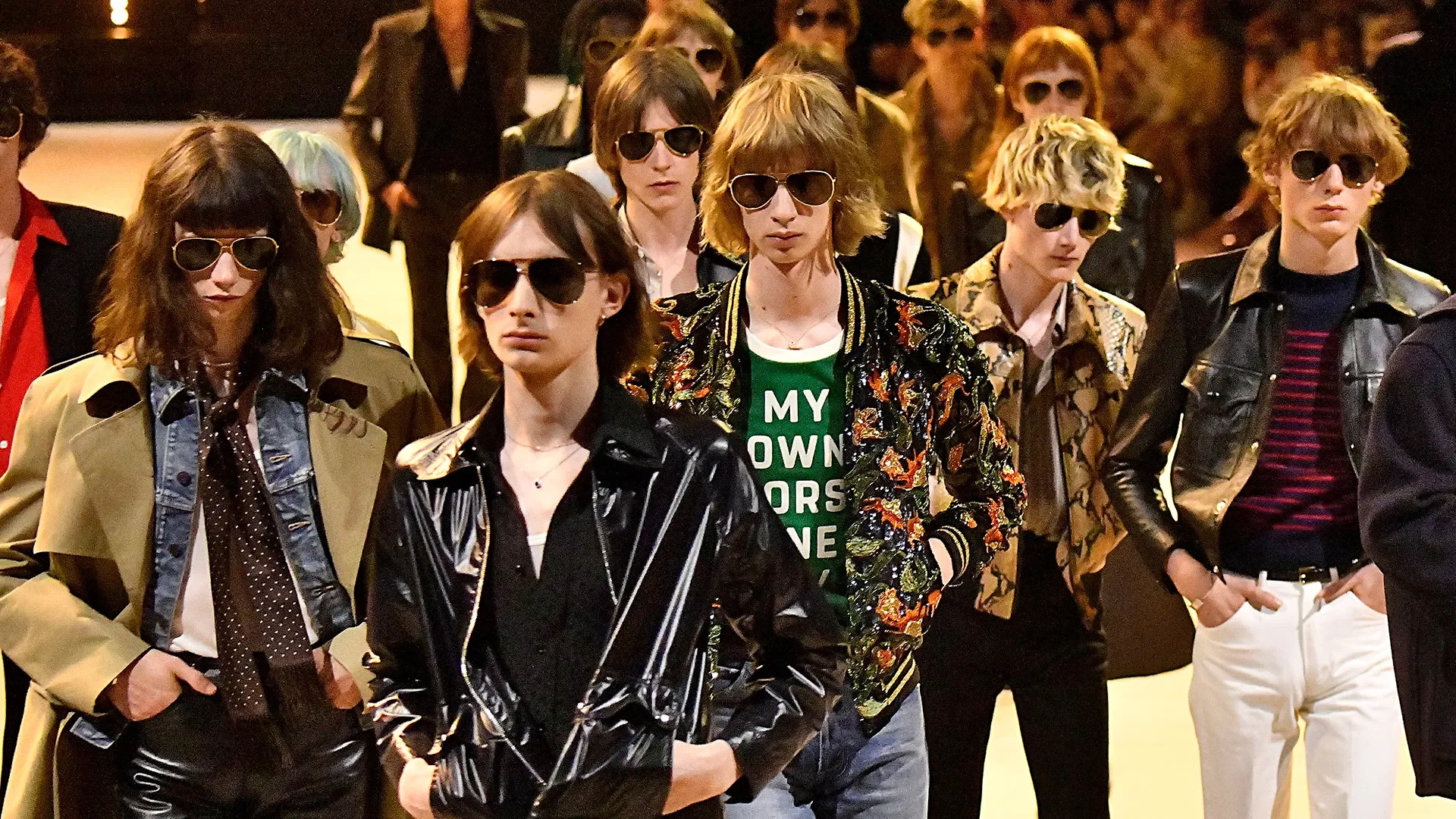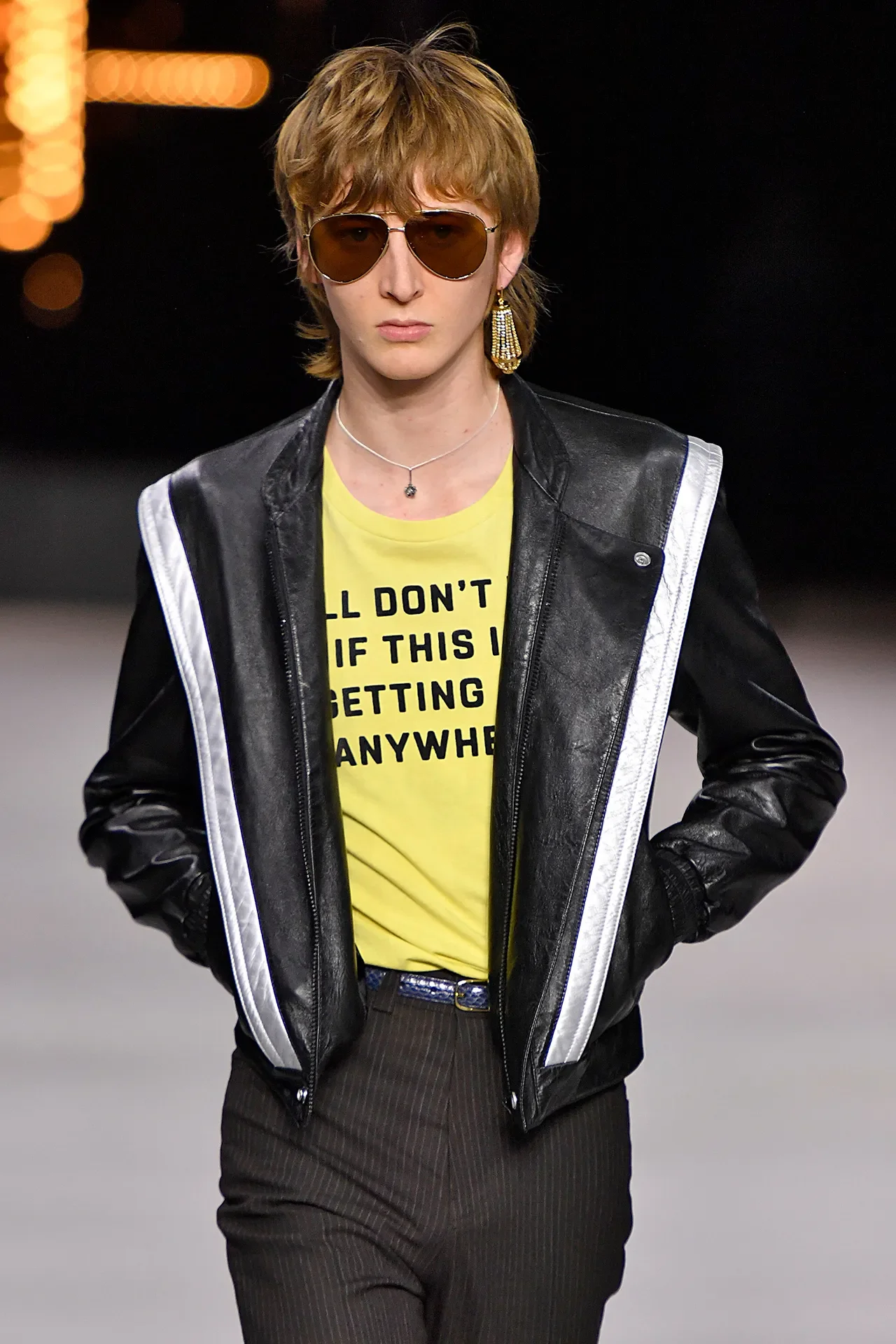Party like a Hedi Boy
A cross between a punk, a dandy, a rockstar, and a gentleman is: a Hedi Boy. Well-fitting leather jacket atop a slightly small tee, or liberally unbuttoned shirt, with an optional tiny scarf. Skinny trousers, possibly flared, heeled boots (the pointier the better), with cigarette in ring-adorned hand, listening to the likes of Yves Tumour, The Dare, The Hellp or Bar Italia- they’re likely a friend of Hedi.
The idea of a ‘Hedi Boy’ comes from an encompassing style, across music and fashion, defined by French designer-cum-photographer, Hedi Slimane. It’s not one limited to boys alone but takes its name from the models who originally reflected this style, though it comes in all forms of sexy androgyny. Following his path from Dior to Saint Laurent to Celine, his designs are renowned for evoking sex appeal, less known for logos or brash embellishments, emphasis is placed upon cut and silhouette, and especially his choosing of models and/or muses - often in the shape of musicians or socialites, or at least where the venn diagram of skinny and sleazy crosses over.
Slimane curated his fashion houses, shot the campaigns, cast the models- it was his vision of cool, and people agree. Because it is. Cigarettes inside the dive bar, full of more people than clothing, the scarce clothing in question likely to be leather or silk. It’s rock and roll haute couture through the smoky lens of a time when hedonism was cool, and it’s back.
What once felt as a scene that existed mainly within a small sub-sect of London, LA, and Paris, has stretched globally, and grown beyond just Hedi Slimane’s designs. It’s a style that’s been run with, evolving every day through the scope of social media and through the newcomers. Where once it would have been blasphemous to stray, now through fresh eyes, the new-gen Hedi Boys shop across designers ranging from more established houses such as Valentino, Ann Demeulemeester and Enfant Riche Deprimes- with the inclusion of more emerging talents brought into this sartorial world, such as the likes of Aaron Esh. Once again we enter a time where models have had more cigarettes than food, and even less sleep. It’s after-party chic, through a dark lens, wrapped in a thin silk scarf.
Often subcultures, or scenes, have ties to music, and the hedi boys are no different. What began in, and still exists within, the school of hedonistic indie, grunge, rock and roll, though as the re-emergence has developed, so have the sonic tastes. The younger wave of this scene find themselves drawn to the likes of electroclash, a genre that is trashy, yet glamorous, and exudes the sweaty party spirit as much now as it did in the 2000s, though wrapped in a different package and seen by more now than ever.
When you look at the generation of artists that these scenesters are following, The Hellp, The Dare- you can see their style origins in The Libertines, The Strokes, The Kills, the first wave of this look, defined by Slimane; skinny suiting-meets-alternative chic. As these artists have emulated the style of the artists they grew up listening to, the aesthetic has trickled down from the indie forefathers to the new wave of the scene, where reference points are similar, the end point has changed, and the outfits have flourished.
Though unlike other sartorial moments that may have revolved mainly around clothing, this is one that’s dressed in the party scene that comes with it. These are luxury clothes designed to look the business, and worn with an attitude to party in. For dancing to genre-bending electronic reimaginings of pop and indie bangers from the mid 2000s/2010s (or classics for the younger part of the crowd). The high-end luxurious clothing paired with sweaty mischief, the dance-until-you-die party ethos. Attitudes and seriousness of military, tailored, and dandy aesthetics countered by distorted trance-pop clash that soundtracks the parties of the scene.
The documentation of this aesthetic and parties have changed hands over the years, though with some remaining constant through the transfiguration it’s undergone. . There’s also Instagram accounts like @thevodkadiary shooting moments in the rough fashion that you’d see on a private account, though as a fly on the wall for these underground moments you’d see professional photographers post after editing days later. And of course, none other than the titular photographer himself, Hedi Slimane capturing this new wave of a scene he birthed himself- with photos impossible to tell of their age, that could have come from an LA band in 2012, or fashion after-party attendees last week. The true sign of an iconic style.
The party of choice for this fringe being Post-Party, held by Wolf and Lux Gillespie, covered by The Face, and championed by Slimane himself. Described as ‘the after party before the after party’, the Post Party oozes the seductive charm that comes from both rock and roll, and Fashion Week combined- people coming dressed their best, to do their worst. It’s infectious and unsurprising that the crowds come in swathes to join the exclusive debauchery- it looks cool and fun, and that’s because it is.
During a time of stylistic or cultural turmoil, straying from hyperbolically sized outfits to the homogenous routine of the pub, whilst discussing the dismal state of global affairs, rise of AI, and brain-rotting social media; it’s no surprise that people yearn for a scene like this, one that revolves around coming together on the dancefloor, dressing well, feeling good and partying hard. In an alluring, yet intimidating, intersection of music and fashion, the lust-laden scene is only ever growing, and the parties are just as, if not more, important than the clothing. As with the outfits as it is with the soundtrack, irony sells- especially when it’s this sexy.
Written by Tom Kelly
Edited by Zak Hardy




